Understanding Food Branding
Effective food branding is crucial for standing out among top food brands. From fast food to artisanal ice cream, successful food branding strategies cover everything from packaging design to social media presence.
Let’s explore the best ideas to create a cohesive brand identity that resonates with your target market.
What is Food Branding?
Food branding is process of creating a unique identity for a food product or brand through various branding strategies. It involves defining a brand message, creating visual elements, and establishing a brand voice to connect with potential customers.
Effective food branding helps brands stand out in a crowded market, making a strong first impression and building long-term customer loyalty. Essential elements of food branding include:
- a distinctive logo,
- appealing packaging design,
- a consistent color palette and
- a clear brand voice.
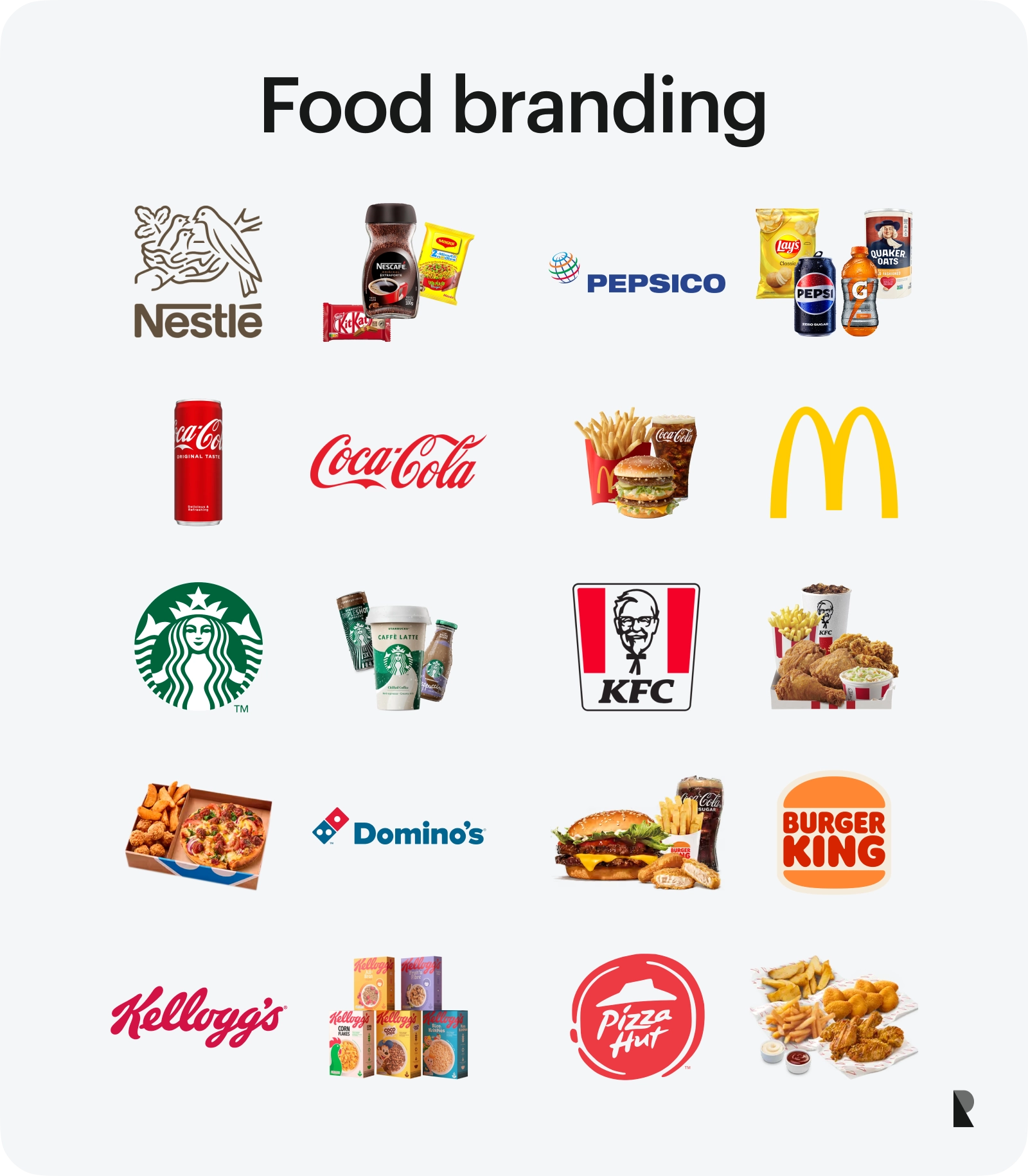
These components work together to create a cohesive brand identity that resonates with the target market. Successful food branding for fast food chains or gourmet ice cream brands relies on these elements to build recognition and loyalty.
Importance of Food Branding
Effective food branding is crucial in enhancing brand awareness, building trust, and driving sales for food brands.
Let’s take a closer look at its role in these important metrics.
Brand Awareness
Brand awareness is crucial when it comes to food, which is an essential part of everyday life.
Food branding helps brands stand out in a crowded market by creating a distinct and memorable identity. Unique logos, eye-catching packaging designs, and consistent color palettes work together to make a lasting first impression on potential customers.
This differentiation is essential for food brands to be easily recognized and remembered, ensuring they remain at the top of consumers' minds when purchasing.
An effective branding strategy also helps create a cohesive brand identity that resonates with the target market. The best food brands use these elements to build brand awareness and establish a strong food and beverage industry presence.
Trust
Establishing credibility and reliability is crucial for building consumer trust, but it doesn’t happen quickly. It requires months, and sometimes years, of consistent branding strategies.
A clear and cohesive brand identity should encompass every aspect of the product, from the brand message to the visual elements like logos and packaging.
These elements must be consistently presented across all channels to build a reliable image. When consumers repeatedly encounter a dependable and familiar brand, their confidence in its quality grows. This increased confidence makes them more willing to purchase and recommend the product to their friends and family.
Over time, this trust leads to stronger customer loyalty and retention, solidifying the relationship between the food brand and its customers. Effective food branding strategies foster trust and enhance overall brand perception, making the brand synonymous with quality and reliability.
Effective food branding also involves transparent communication about the product’s quality, sourcing, and values, reinforcing trust. Fast food brands, for example, emphasize hygiene and quality standards to build trust with their customers.
Sales
Attractive packaging design and a strong brand presence are pivotal drivers of sales for food products. The packaging and brand narrative are often consumers' first interaction with your product.
If these elements fail to captivate them, they may not try your product, regardless of its quality. Effective food and beverage branding catches the eye and influences purchasing decisions by conveying quality and value.
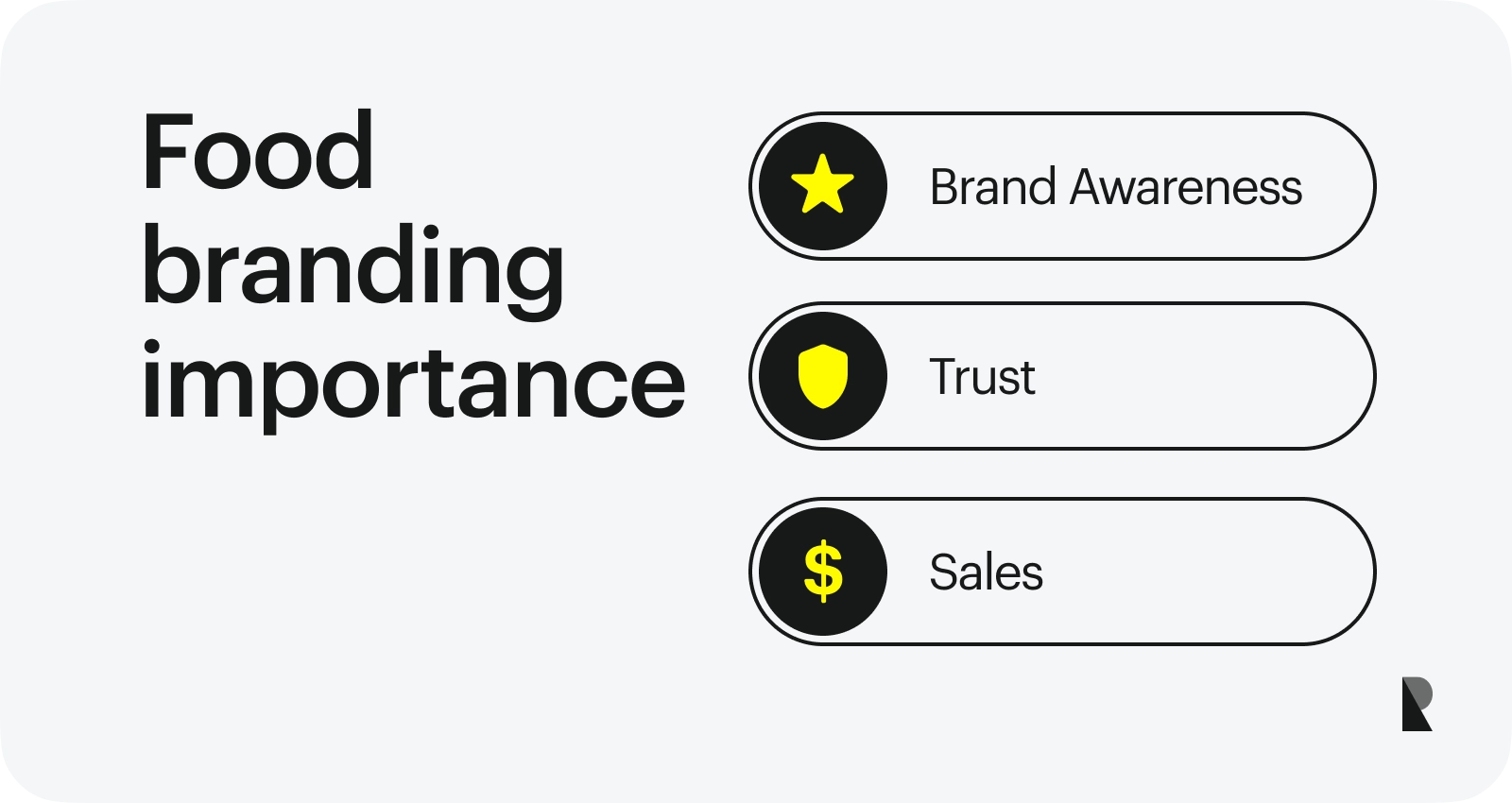
Social media marketing and promotional campaigns also significantly contribute to driving sales by reaching a wider audience and showcasing the product's best features. This is especially crucial for niche products such as vegan meat or Chinese spices.
Your website and social media pages should align with the overall vibe of your product.
For instance, if you sell Chinese spices, incorporating elements of Chinese paintings and hieroglyphs can underscore the uniqueness of your product and increase sales, leading to sustained growth.
Key Elements of Successful Food Branding

Logo Design
A well-designed logo should be simple, versatile, and reflective of the brand's identity. It should capture the essence of the food brand and be easily recognizable across various platforms, from packaging design to social media. For example, the iconic McDonald's golden arches are instantly recognizable and convey a sense of familiarity and trust.
Key principles include simplicity, scalability, and relevance to food products or brands. Logos should also be adaptable to different sizes and formats while maintaining clarity and impact.
Packaging
Effective packaging design protects the food product from damage and is a powerful marketing tool.
Design tips include:
- using high-quality materials that reflect the brand's values,
- selecting colors that align with the brand identity, and
- choosing shapes that stand out on the shelf.
For instance, the minimalist and eco-friendly packaging of brands like Boxed Water appeals to environmentally-conscious consumers.
Packaging should also provide clear information and create an enjoyable unboxing experience, reinforcing the brand message and values.
Color Palette
Selecting an appropriate color palette is vital in food branding, as colors have a profound psychological impact on consumers.
Colors can evoke specific emotions and associations; for example, red can stimulate appetite and excitement, making it popular in fast food branding. A cohesive color scheme helps create a consistent brand identity and aids in brand recognition.
For instance, Starbucks uses dark shades of green to signify relaxation and sustainability, which aligns with its brand message.
When choosing a color palette, consider the target market and the emotions you want to evoke, ensuring the colors align with the overall branding strategy.
Brand Voice
Defining and implementing a consistent brand voice is crucial for building a strong connection with potential customers. The brand voice is an integral part of food branding that should reflect the brand's personality and values, whether playful, casual, professional, or authoritative.
For example, the well-known ice cream brand Baskin-Robbins uses a friendly and playful tone in its marketing materials, such as its "31 flavors" concept, suggesting fun and variety for customers of different ages and tastes.
Consistency in tone and style across all communication channels, including social media, packaging, and advertising, helps build trust and loyalty.
A well-defined brand voice ensures that all brand messages are clear, relatable, and engaging, enhancing the percentage of positive brand experiences among customers.


Brand identity made by Ramotion for food brand Nelio
Steps to Build a Strong Food Brand
Step 1. Market Research
Conducting thorough market research is crucial for understanding your target audience and competitors in the food industry.
Start by identifying consumer trends and needs to uncover gaps in the market that your brand can fill.
Also, analyze demographic data, consumer behavior patterns, and competitor strategies to gain insights into what appeals to your potential customers.
For example, a vegetarian food brand Beyond Meat conducted extensive market research to understand the growing demand for plant-based protein among health-conscious consumers, positioning itself as a leader in the alternative meat industry.
Step 2. Defining Unique Selling Proposition (USP)
Crafting a distinctive USP is essential for setting your food brand apart from competitors. Your USP should highlight what makes your product unique and why consumers should choose it over others.
Elements of a compelling USP include:
- identifying your product's key benefits,
- addressing consumer pain points and
- emphasizing what makes your brand different.
For instance, Chipotle's emphasis on using fresh, sustainable ingredients and customizable menu options appeals to consumers looking for healthier fast food alternatives.
Step 3. Creating a Brand Story
Developing an engaging brand story helps connect your audience emotionally and build brand loyalty.
Your brand story should articulate your brand's mission, values, and journey in a way that resonates with consumers.
Successful examples include the ice cream Ben & Jerry's, known for their commitment to social responsibility and activism, and how they started making ice cream in a renovated gas station in Vermont.
Another example is KIND Snacks, which tells the story of its founder's mission to create snacks with simple, whole ingredients that taste good and do good.
Step 4. Designing Visual Identity
People trust what they see, so a strong visual identity is essential for creating a recognizable and cohesive brand image in food branding.
Start by designing a logo that reflects your brand's personality and values, using colors and typography that align with your brand message.
Successful examples of visual identities include the sleek and minimalist design of Apple's packaging, which reflects their commitment to innovation and quality, and the vibrant and playful design of M&M's packaging, which appeals to consumers of all ages.
Step 5. Testing and Refining Your Brand
Testing your brand elements and gathering feedback is essential to ensure they resonate with your target audience.
Conducting focus groups, surveys, and usability tests is crucial for gathering honest customer opinions. These methods provide valuable insights that help refine your brand strategy and adjust your branding elements based on real consumer feedback.
For example, PepsiCo continuously tests and refines its brand message and product offerings based on consumer feedback and market trends, ensuring they remain relevant and appealing to their target market.
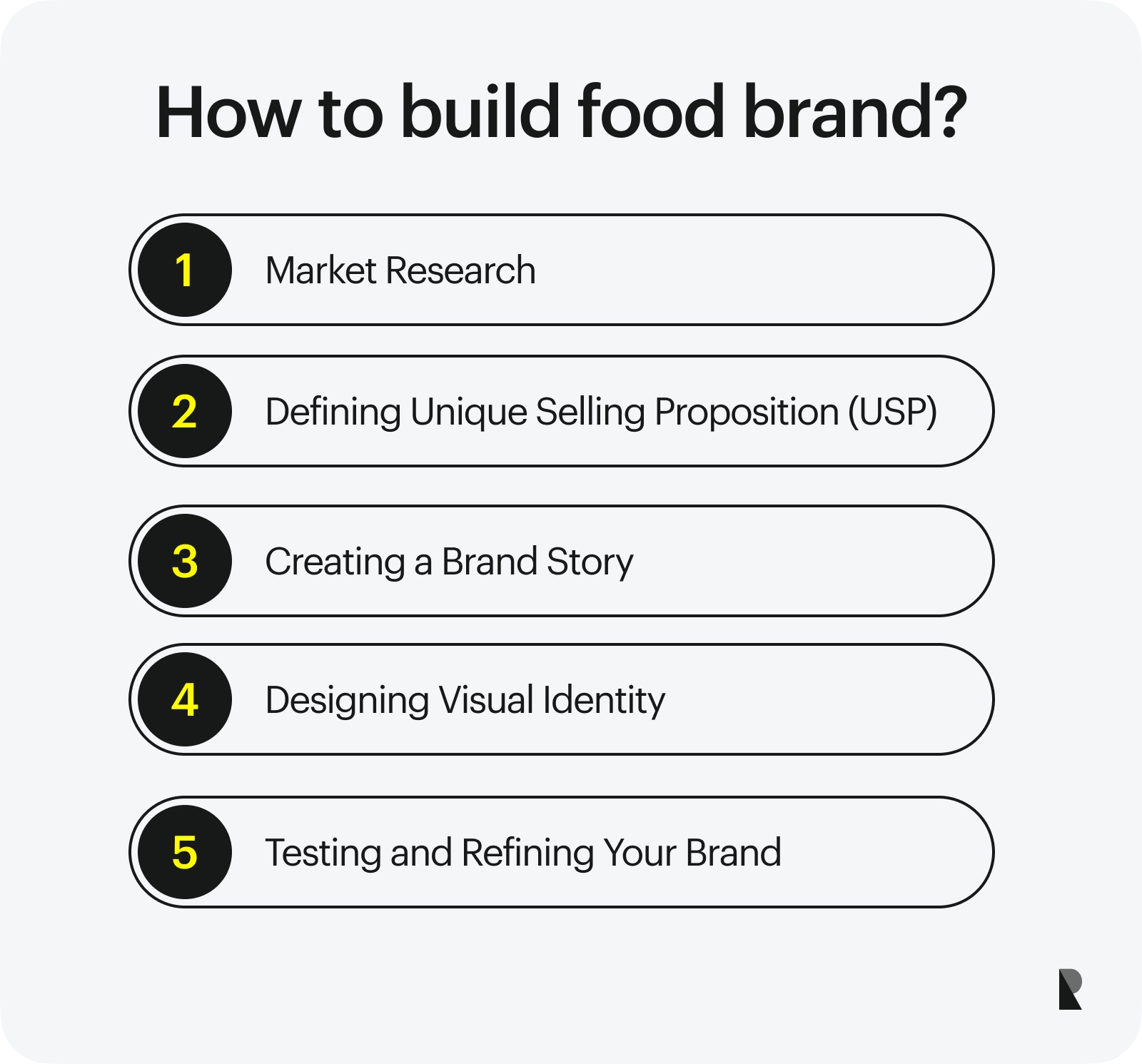
Promoting Your Food Brand
Here are strategies for effective brand promotion across various channels:
Social Media Marketing
Social media marketing is one of the main strategies for engaging with your audience and building brand awareness.
If you want to make the most of your social media marketing, start by creating compelling content that resonates with your target audience, such as behind-the-scenes videos, recipe tutorials, and user-generated content.
Use social media advertising to reach a broader audience and promote your products and analytics to track performance and optimize your campaigns.
For example, Oreo uses creative and interactive content on Instagram to engage with their followers and encourage user participation in their campaigns.
Influencer Marketing
Influencer marketing can significantly boost your brand's visibility and credibility. Collaborate with influencers who align with your brand values and have a genuine connection with your target audience.
Make sure they have a strong engagement rate, a good reputation, and reach within your niche for effective brand promotion.
When you have chosen a prominent social media personality to promote your brand, give them creative freedom while ensuring they effectively convey your brand message.
This approach allows influencers to resonate genuinely with their audience, enhancing your brand's credibility and reach.
For example, Coca-Cola collaborates with influencers to promote new beverage launches and connect with a younger demographic, leveraging their influence to strengthen brand presence and engagement.
Trade Shows and Events
Participating in trade shows and events offers excellent opportunities to showcase your food or drink brand and connect directly with potential customers. To make the most of these events, ensure your booth setup is eye-catching and aligns closely with your brand identity.
Additionally, you need to have informative materials such as brochures and product catalogs available for attendees to take home, providing them with detailed information about your products.
To align your materials with your mission and vision, collaborate with a specialized brand identity design agency that understands and can visually articulate your core values and goals.
Engage with visitors by offering tastings, demonstrations, and interactive experiences, creating a memorable impression and fostering meaningful connections with your brand.
This direct engagement can increase brand recognition and customer loyalty over time.
Checkout how brand Nelio with assistance of Ramotion experts have presented their brand via event:
Checkout Nelio Case on Bēhance
Case Studies of Successful Food Brands
Premier Foods
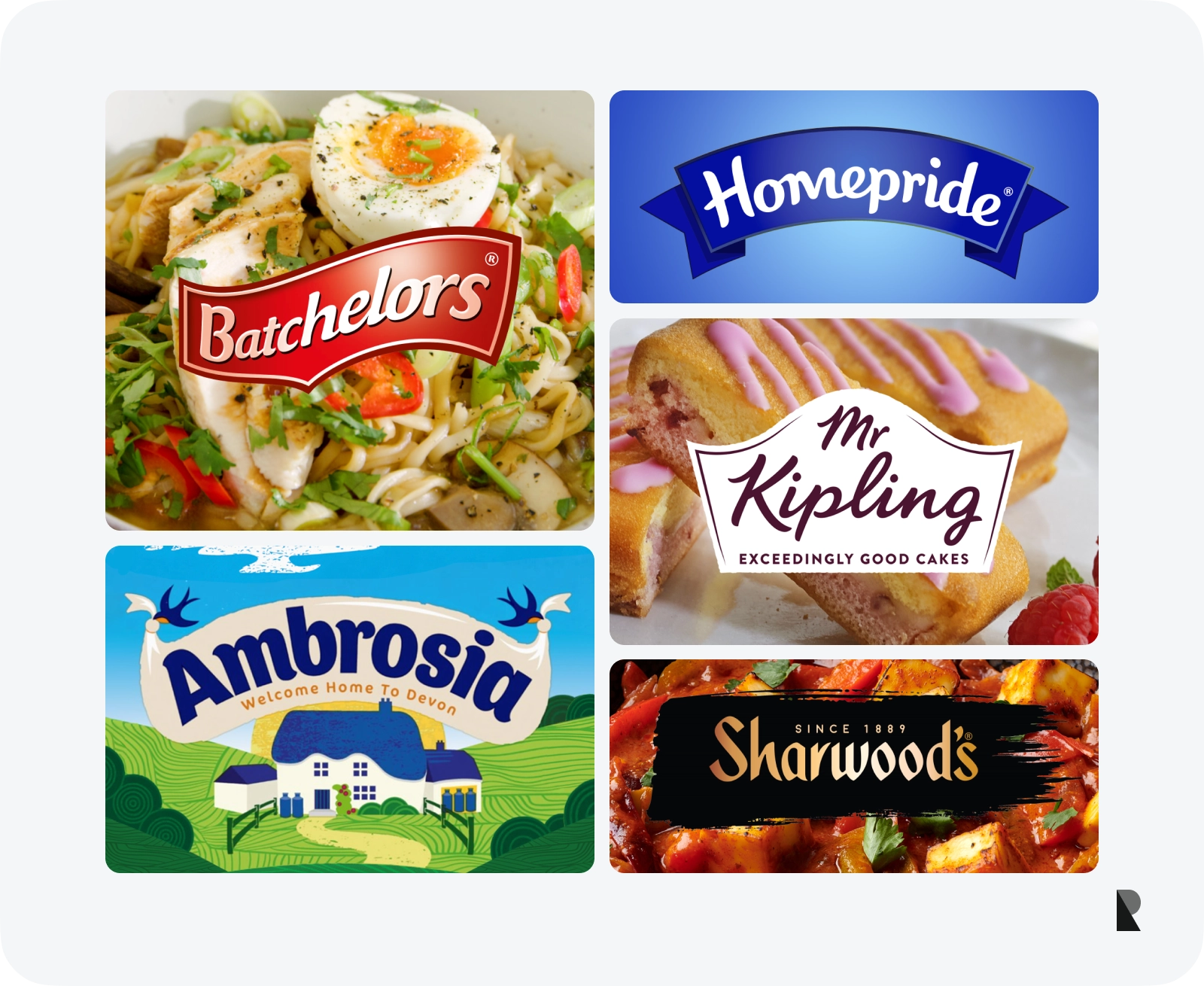
Premier Foods is a prominent food processing company based in the United Kingdom. It is known for its diverse range of products, including breakfast cereals, biscuits, cakes, and snacks.
First, Premier Foods leverages its extensive portfolio of well-known brands, such as Mr. Kipling, Cadbury, and Bisto, which have garnered strong consumer loyalty. These brands are synonymous with quality and taste, appealing to a wide demographic.
Besides, Premier Foods focuses on innovation, regularly introducing new products and flavors to meet evolving consumer preferences. This proactive approach to product development ensures that the company remains competitive in the highly dynamic food industry.
Lucky Saint
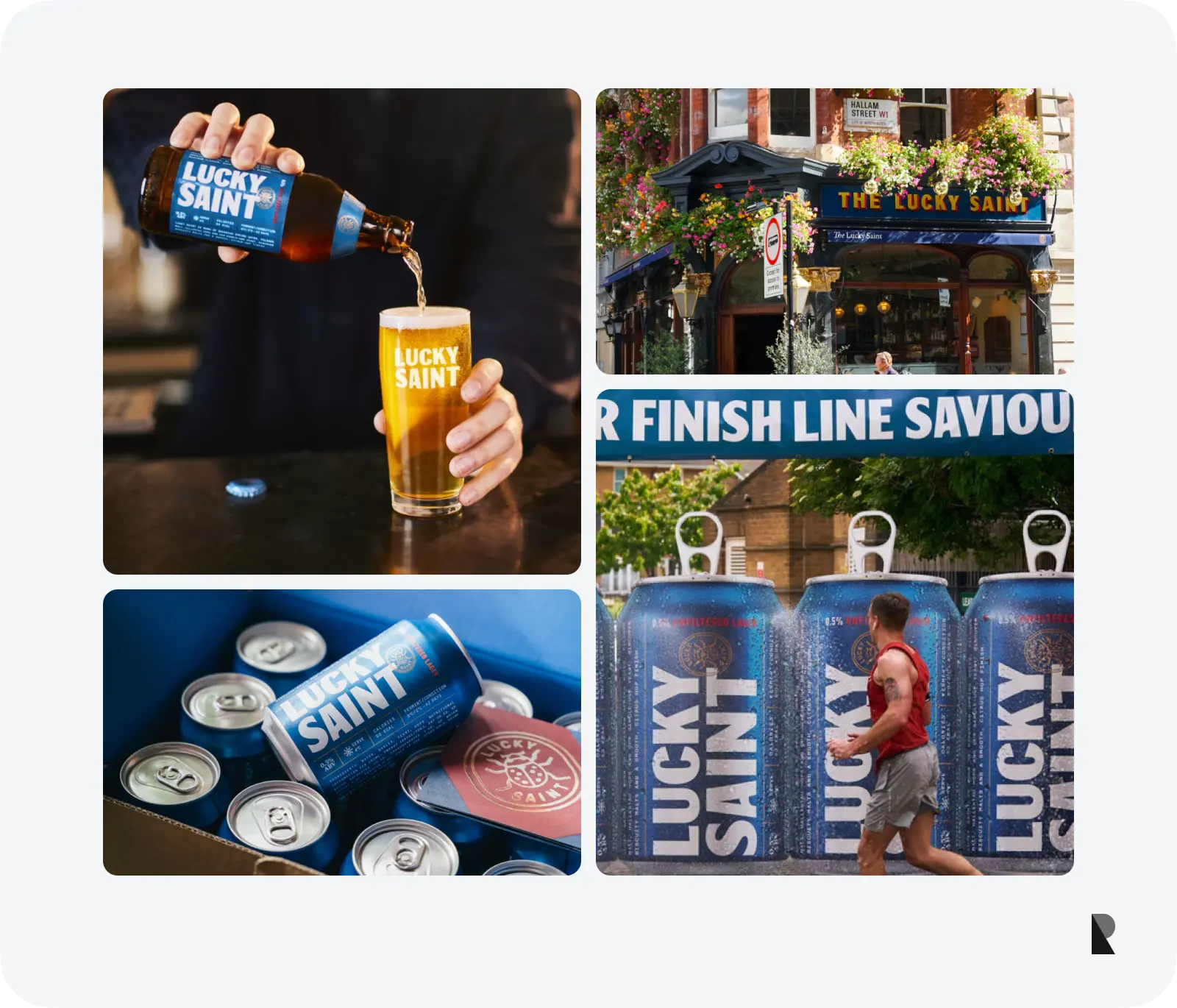
Lucky Saint Food is renowned for its fusion of Asian and Western cuisine, offering unique and delicious dishes that appeal to people with different tastes. Known for its casual atmosphere and exceptional food and drink options, Lucky Saint has carved out a niche in the competitive restaurant industry.
The key strategies behind Lucky Saint's success include focusing on high-quality ingredients sourced locally and globally, which ensure authenticity and freshness in every dish. Additionally, Lucky Saint leverages social media and word-of-mouth marketing to build a loyal customer base and attract new clients. Lucky Saint has become a beloved dining destination known for its innovative approach to culinary fusion by consistently delivering on its promise of delicious food and excellent service,
Savu Parrilla
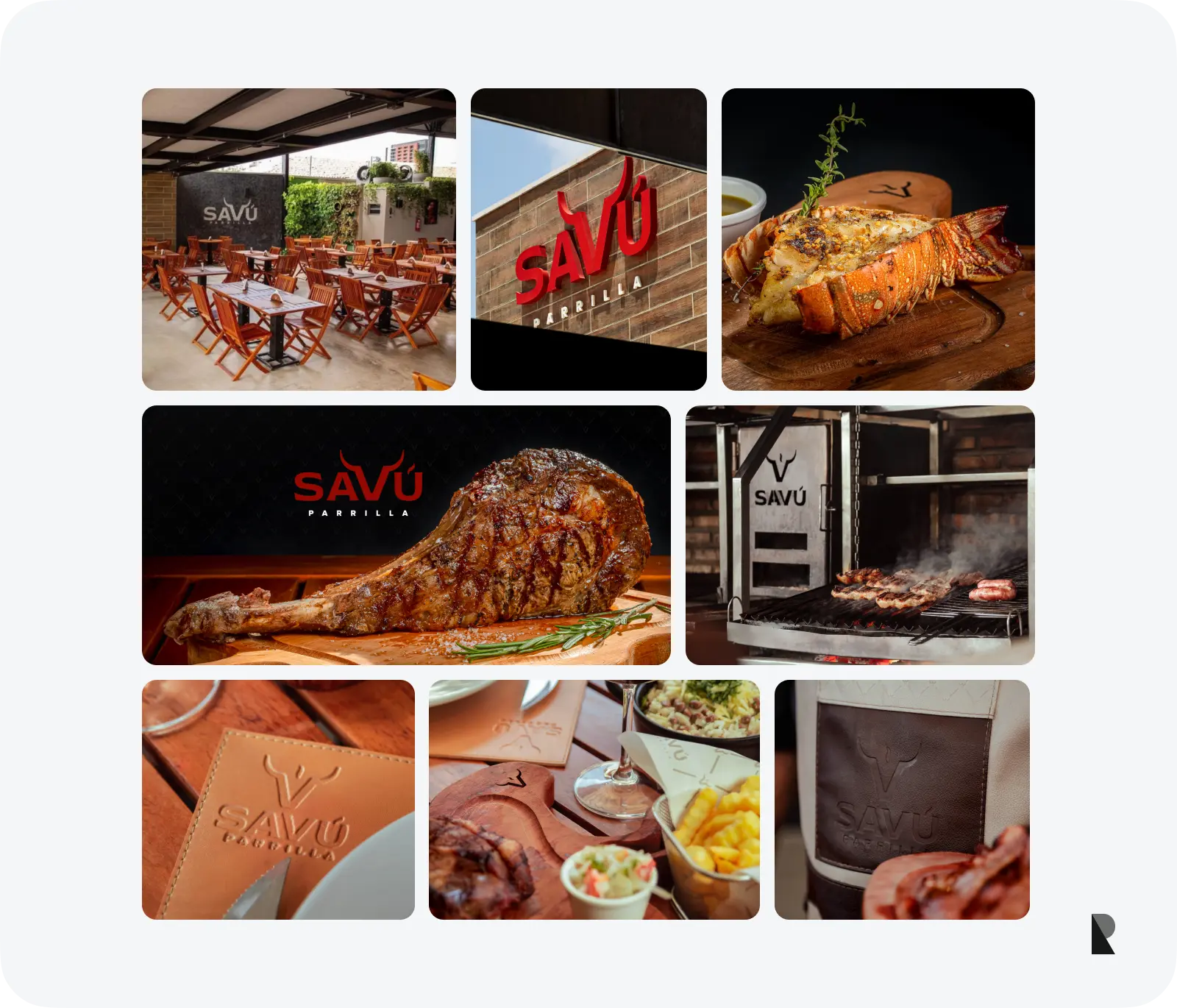
Savu Parrilla is a popular restaurant specializing in Spanish and Latin American cuisine. Its menu includes tapas, paella, and grilled meats. The restaurant's branding approach focuses on creating a memorable dining experience centered on exceptional food and drink options and warm hospitality.
Savu Parrilla has successfully built a reputation among both locals and tourists as a go-to destination for special occasions and romantic dinners.
The restaurant's commitment to quality and authenticity, strategic location, and inviting ambiance have contributed to its sustained success in the competitive restaurant industry.
As we can see from these case studies, each brand has effectively leveraged its unique strengths to build strong customer loyalty and achieve prominence within their respective markets.
Conclusion
Effective food branding is crucial for standing out in the competitive food and drink market, where countless products appear on store shelves daily, making it increasingly challenging to capture consumer attention.
Understanding your target audience is essential to crafting a unique selling proposition that resonates with them, creating a compelling brand story, and designing a solid visual identity. Each of these aspects can either make or break your food brand.
Innovation, quality, and consistent brand messaging are essential components that contribute to success in the food industry.
Applying these strategies and continuously refining your approach based on consumer feedback is key to achieving lasting success in the competitive and dynamic food and drink industry.
Jun 24, 2024
